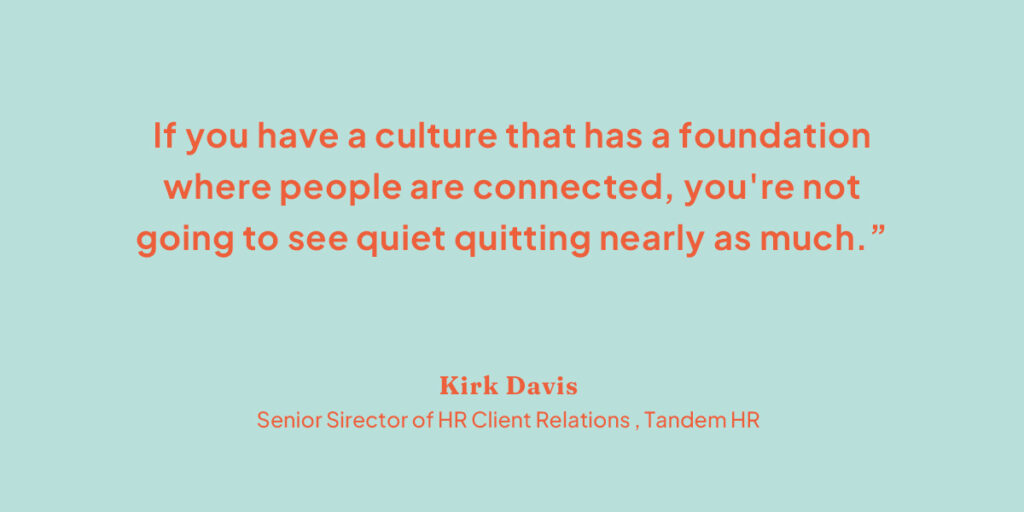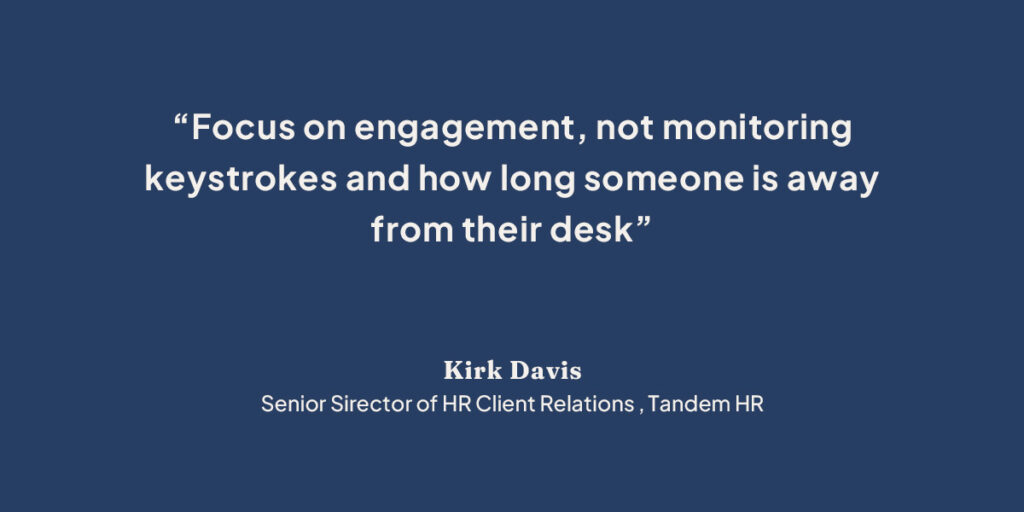Quiet quitting – that big-time buzzword that’s anything but hush, hush.
Even after the pandemic, quiet quieting remains a hot topic in the media and among LinkedIn’s armchair business experts. Since January 1, an average of nearly 100 news stories have referenced it daily in the U.S., according to search data from Meltwater, a global media monitoring firm. And – on the surface – it remains a topical issue for good reason.

No business leader wants to worry their employees aren’t resigning but are instead opting to quietly fade out of a job. That kills productivity, morale and stings the bottom line. But here’s the thing: If your organization prioritizes employee engagement, good management and a great culture, then you’re not going to have an issue with quiet quitting.
Kirk Davis, Tandem HR’s senior director of HR client relations, said a consistent theme he continues to see among businesses dodging the “quiet quitting” freight train, is that they’re intentional with how they keep employees involved and interested in their work.
“If you’re doing what you need to do by way of recognition and appreciation of your employees then that’s going to help significantly,” Davis said. “If you have a culture that has a foundation where people are connected, you’re not going to see quiet quitting nearly as much.”

One-on-ones for the win
A priority when advising business leaders is for help them focus on prioritizing one-on-one meetings with their team members, Davis said.
Yes, these meetings can happen organically in the break room or at the end of a Zoom call. But it’s incredibly important to be intentional with these meetings. Instead of hoping they happen, schedule at least 15 minutes monthly with each employee on your team. If your team is small, have these meetings weekly.
“When you put these meetings on your calendar it’s a small but effective strategy that shows your intention, and that you truly care about your team,” Davis said.
During these meetings don’t focus as much on business issues. Instead, make it a priority to build relationships with individuals on your team. Talk them about their kids. Ask them what they’re up to on the weekend or how their parents are doing. But here’s the secret: You have to care; you have to want to build these relationships and actively listen. Otherwise, it’s not valuable to you or your employees.
For Davis, he often uses one question to better understand what his team members are dealing with outside of work. It’s not because he is formulaic. It’s because this one question often has an ever-changing answer and captures so much so quickly.
That question: What’s causing you the most stress outside of work and what’s bringing you the most joy?
“You ask those questions and then you listen intently,” Davis said. “You don’t forget their responses. You follow up with them the next time you talk and see how they’re doing with those things. This is real relationship building – a basic human skill – but it goes incredibly far when it comes to creating culture, keeping employees engaged, and reducing what’s now so commonly called quiet quitting.”
Build trust. Reduce quiet quitting.
If you’re not continually working to build trust with your employees, you’ll run the gamut of employee engagement issues. And when that happens, quiet – and not-so-quiet – quitting becomes commonplace.
Of course, what matters to people differs, but in general it’s rarely directly related to work, Davis said. Instead, focus on the small things. Pay attention to the details and what’s happening in an employee’s life.

“I’ve done so many exit interviews and way too often I hear people say things like ‘after three years no one ever recognized my birthday’,” Davis said. “Employees leaving an organization bring up these types of issues far more than topics such as salary or other tangible things tied to their jobs.”
For that reason, Davis recommends businesses put their resources toward creating a strong culture and meaningful employee engagement, rather than obsessing over big-brother tactics, which create distrust and paranoia.
“Focus on engagement, not monitoring keystrokes and how long someone is away from their desk,” Davis said. “If you can spend 20 minutes doing that, you can spend 20 minutes talking with a team member. And you’ll learn pretty quickly that the latter is far more effective when it comes to keeping employees from heading down a path toward quiet quitting.”

